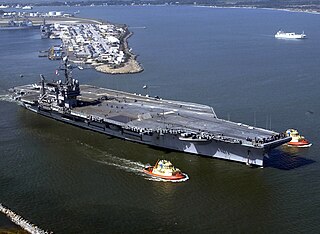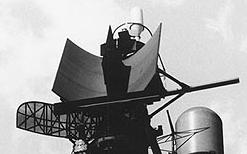
USS Kitty Hawk (CV-63), formerly CVA-63, is a decommissioned United States Navy supercarrier. She was the second naval ship named after Kitty Hawk, North Carolina, the site of the Wright brothers' first powered airplane flight. Kitty Hawk was the first of the three Kitty Hawk-class aircraft carriers to be commissioned and the last to be decommissioned.

Aerospace is a term used to collectively refer to the atmosphere and outer space. Aerospace activity is very diverse, with a multitude of commercial, industrial and military applications. Aerospace engineering consists of aeronautics and astronautics. Aerospace organizations research, design, manufacture, operate, or maintain both aircraft and spacecraft.

USS John F. Kennedy (CV-67), the only ship of her class, is an aircraft carrier, formerly of the United States Navy. Considered a supercarrier, she is a variant of the Kitty Hawk-class, and the last conventionally powered carrier built for the Navy, as all carriers since have nuclear propulsion. The ship was named after John F. Kennedy, the 35th President of the United States. John F. Kennedy was originally designated a CVA, for fixed wing attack carrier, however the designation was changed to CV, for fleet carrier.

The Kitty Hawk-class supercarriers of the United States Navy were an incremental improvement on the Forrestal-class vessels. Three were built, all in the 1960s, Kitty Hawk (CV-63) (1961–2009), Constellation (CV-64) (1961–2003), and America (CV-66) (1965–1996), as well as the variant John F. Kennedy (CV-67) (1967–2007). All are now decommissioned.
Purchasing is the process a business or organization uses to acquire goods or services to accomplish its goals. Although there are several organizations that attempt to set standards in the purchasing process, processes can vary greatly between organizations.

USS Kitty Hawk (APV-1/AKV-1), formerly SS Seatrain New York, was a cargo ship that was converted into an aircraft transport during World War II.
Integrated logistic support (ILS) is a technology in the system engineering to lower a product life cycle cost and decrease demand for logistics by the maintenance system optimization to ease the product support. Although originally developed for military purposes, it is also widely used in commercial customer service organisations.

The America class is a ship class of landing helicopter assault (LHA) type amphibious assault ships of the United States Navy (USN). The class is designed to put ashore a Marine Expeditionary Unit using helicopters and MV-22B Osprey V/STOL transport aircraft, supported by AV-8B Harrier II or F-35 Lightning II V/STOL aircraft and various attack helicopters. The first of these warships was commissioned by the U.S. Navy in 2014 to replace USS Peleliu of the Tarawa class; as many as eleven will be built. The design of the America class is based on that of USS Makin Island, the last ship of the Wasp class, but the "Flight 0" ships of the America class will not have well decks, and have smaller on-board hospitals to provide more space for aviation uses.
Destroyer minesweeper was a designation given by the United States Navy to a series of destroyers that were converted into high-speed ocean-going minesweepers for service during World War II. The hull classification symbol for this type of ship was "DMS." Forty-two ships were so converted, beginning with USS Dorsey (DD-117), converted to DMS-1 in late 1940, and ending with USS Earle (DD-635), converted to DMS-42 in mid-1945. The type is now obsolete, its function having been taken over by purpose-built ships, designated as "minesweeper (high-speed)" with the hull classification symbol MMD.

Junk box is a term used by amateur radio operators (hams) to describe a collection of spare parts and old equipment kept to assist in building and repairing their station. Typical items found in a junk box are electronic components such as resistors and capacitors as well as small parts such as screws, nuts and bolts. A junk box may also contain surplus, cast off or used electronic gear. Radio amateurs who construct their own equipment, known as homebrewers, often have large or well stocked junk boxes.
Diminishing manufacturing sources and material shortages (DMSMS) or diminishing manufacturing sources (DMS) is defined as: "The loss or impending loss of manufacturers of items or suppliers of items or raw materials." DMSMS and obsolescence are terms that are often used interchangeably. However, obsolescence refers to a lack of availability due to statutory or process changes and new designs, whereas DMSMS is a lack of sources or materials.

The AN/SPG-55 was an American tracking / illumination radar for Terrier and RIM-67 Standard missiles (SM-1ER/SM-2ER). It was used for target tracking and surface-to-air missile guidance as part of the Mk 76 missile fire control system. It was controlled by a UNIVAC 1218 computer.

Helicopter Sea Combat Squadron 14 (HSC-14) "Chargers" is an aviation unit of the United States Navy based at Naval Air Station North Island, California (USA). HSC-14 was established as Helicopter Anti-Submarine Squadron 14 (HS-14) in 1984 and was redesignated HSC-14 in 2013. The squadron is equipped with the Sikorsky MH-60S Seahawk.
A spare part, spare, service part, repair part, or replacement part, is an interchangeable part that is kept in an inventory and used for the repair or refurbishment of defective equipment/units. Spare parts are an important feature of logistics engineering and supply chain management, often comprising dedicated spare parts management systems.
HEICOCorporation is an aerospace and electronics company that focuses on niche markets.

Vice Adm. Mark David Harnitchek became director of the Defense Logistics Agency in November 2011. As such, he is responsible for providing the military services and other federal agencies with logistics, acquisition and technical services. These services include logistics information; materiel management; procurement, warehousing and distribution of spare parts, food, clothing, medical supplies and fuel; reutilization of surplus military materiel; and document automation and production.

Aircraft recycling is the recycling industry of aircraft. It involves the scrapping and disassembling of retired aircraft, and re-purposing their parts as spare parts or scrap.
Robert William Jackson is a US Navy veteran who served as a second class petty officer on the USS Kitty Hawk and became a whistleblower. In the eighties, Jackson denounced the use of the USS Kitty Hawk to sell F-14 parts and missiles to Iran illegally. Later, it was discovered that this ring of smugglers was part of a wider operation involving three different US Navy carriers, and an essential part of a more significant conspiracy, later referred to as the Iran–Contra affair.

AN/SPS-39 is a three-dimensional radar was manufactured by Hughes Aircraft Company. It was used by the US Navy as a parabolic-cylinder reflector antenna after World War II, and was equipped aboard naval ships during the Cold War. It was mass-produced based on AN/SPS-26, and was also the first 3D radar deployed by the US Navy in the fleet. It later evolved into an improved AN/SPS-52.











